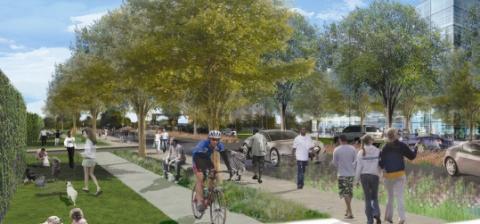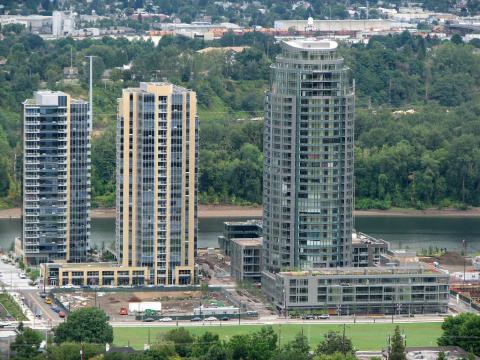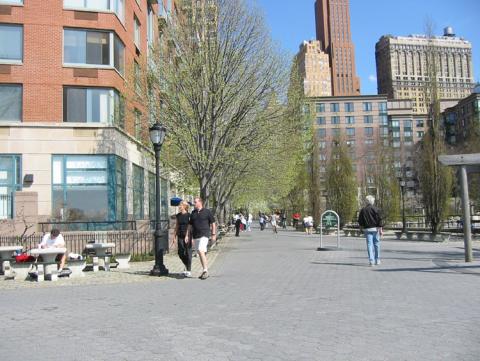Stuart Weitzman School of Design
102 Meyerson Hall
210 South 34th Street
Philadelphia, PA 19104
Get the latest Weitzman news in your Inbox
Over the next ten years, we should extend key streets to reconnect the river with the city and create access for residents.
Extend key streets to the river to provide multiple safe, efficient and attractive routes for cars, pedestrians and cyclists. Currently, many city streets dead-end at I-95 or Delaware Avenue/Columbus Boulevard and do not provide access to the riverfront. Over the next ten years, key east-west streets to the river can be extended through existing parking lots, service roads or vacant private land. In this way, public access to the riverfront can be significantly improved. In addition, because these key streets will connect the river with existing neighborhoods, the likelihood that investors will face the risks of a thin line of isolated development at the water’s edge is greatly reduced (54).

Below is a list of streets that can be extended within the next ten years without impacting a single viable business or residence. Extending a Philadelphia street is a two-part process. First the street is platted, meaning that it is added to the City Plan. While the actual street does not yet exist, its presence on the official City Plan preserves the right-of-way and stops developers from locating buildings on that and other future road sites. The second step is the construction of the road extension. Neither is easy to accomplish. To plat a street, the city requires a public hearing, full City Council vote and the mayor’s signature. In addition, the city often asks adjacent owners to sign an indemnification agreement stating that they will not sue the city for damages they may suffer because of the presence of the road in the plat. Even though the extensions listed at right only add at most a couple of blocks to the existing streets and often go through parking lots or along existing alley streets, getting them platted will require significant political leadership, property-owner cooperation and citizen support.
Key streets to extend to the river
Numerous streets have been extended across Battery Park City to the river's edge, facilitating public access to and increasing the success of its promenade and public spaces.
Short-Term Actions
- Identify key streets that can be extended without impacting viable homes or businesses.
- Plat streets on City Plan to reserve the right of way.
- Enforce reserved street rights-of-way to ensure that development does not impede future streets.
- Purchase necessary vacant properties to extend streets.
Longer-Term Actions
- Fund public street construction when development in area of platted street occurs or as part of a Streets Department five-year plan.
Civic Actions: What Philadelphians Can Do
- Support street extensions to river.
- Work with city Office of Transportation to ensure that street extensions accommodate cars, bicycles and pedestrians safely.
- Support greening of river neighborhood streets to filter stormwater and keep sewers from sending combined sewer overflows into the river.
Benefits and Impact
Economic: East-west streets expand the investment area, prevent a single thin line of water’s edge development and make it easier for customers to frequent riverfront businesses.
Environmental: Will limit emissions from clogged traffic and create pedestrian and bicycle alternatives.
Community: Will improve access to the river, connect neighborhoods with the river and improve overall circulation and accessibility.
Impact on City Budget: Platting streets is a difficult process but there is virtually no cost outside of staff time. The cost to construct a typical 34-foot wide residential street in Philadelphia is approximately $957 per linear foot. This price includes subgrade prep, base course, wearing course, curbs, sidewalks, lighting, inlets and street trees. It does not include underground utilities. This price also assumes good soil conditions. The need for pilings adds significant costs. In 2007, 1800 feet of roadway were built for $2 million (55).
Other Cities Have Done It - We Can Too
In Camden, in order to create an accessible waterfront district, the Cooper’s Ferry Development Association obtained $4.5 million in grants to pay for extension of six streets (56). With a grant of $3.2 million from New Jersey Department of Transportation (NJDOT) and $1.2 million from the Economic Recovery Board (ERB), Camden extended Riverside Drive, created Arch and Aquarium Drive and improved Market Street. Cincinnati extended its major east-west streets to the river in order to create a truly accessible, city-scale riverfront. Cincinnati financed its street extensions with City Capital Dollars, federal transportation grants and a TIF (57). For Portland’s South Waterfront, the city agreed to finance street and sidewalk construction for the north-south streets, while the developers paid for street construction for the east-west streets (with each developer being responsible for connections in their land). The total cost to the city for its road construction was about $13 million. Portland raised this money from grants, impact fees and a TIF district (58).

Extending the downtown street fabric across Portland's South Waterfront has made its parcels very lucrative for private development.
Funding Resources
- Hometown Streets (PennDOT and Growing Greener Program): Funds the repair, redesign and reconstruction of main streets, commercial corridors and major boulevards in older communities to support local revitalization plans. Eligible projects include sidewalk improvements, street lighting, pedestrian crossings, traffic calming, bicycle amenities and transit-bus shelters. The program will not cover the costs of street paving, stormwater management and traffic signals. The program uses federal funds and requires a minimum 20 percent local match. Grants are awarded for up to $1 million per project.
- Local Municipal Resources and Development Program (DCED): This program makes grants to municipalities for the construction or rehabilitation of infrastructure, the acquisition and demolition of structures/land, public safety, crime prevention and recreation. Typical grants are between $5,000 and $25,000.
- Transportation Enhancement Program (PennDOT, DVRPC): This program funds streetscape improvements, bicycle facilities and the acquisition of scenic easements and scenic or historic sites.

